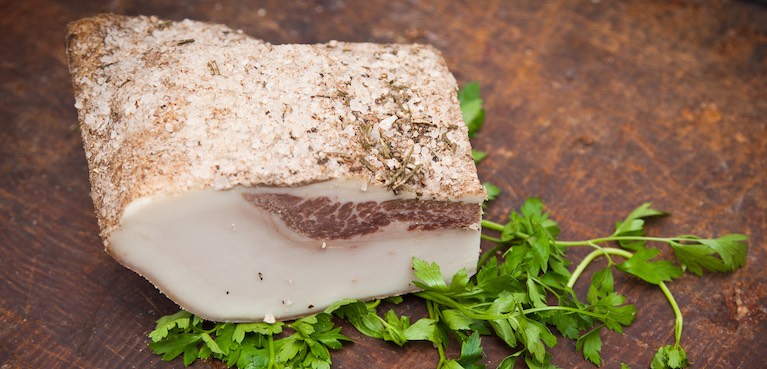In this post we’re going to dive into lardo – a delicious specialty pork product derived from the back of a pig.
What is lardo, exactly? A layer of firm adipose (fat) tissue under the back skin differs from the fat found elsewhere on a pig. When thinking of pork fat, you’ll likely think of pork belly or bacon. However lardo is a noticeably different texture.
In the US, we would call this part of the pig the “fatback”, or if you’re in the south you might call it “streak o’ lean”. In Ukraine, Russia, or other former-soviet countries it’s called “salo”. Hungarians call their smoked version “szalonna”. In Bulgaria and Romainia it’s salt-cured and called “slanina”. In Mexico it’s called “lonja de cerdo” and is fried until crispy as an alternate form of chicharron. This list of global variations of what the Italians call lardo is far from exhaustive. Ultimately, it’s unsurprising that a particular part of one of the world’s favorite livestock has a wide variety of names and preparations!
Practically, lardo is the same thing as Fatback – similar to how Italian polenta is the “same thing” as polenta. It comes from the same thing, but there are some differences. In particular, the preparation and way it’s consumed is what makes it stand apart.
History of Lardo
Like many aspects of Italian cuisine, the roots of lardo as a culinary product trace their origins to the Roman empire. An ancient marble quarry resides in the town of Cararra, just outside Colonnata in Tuscany. The great Michelangelo traveled to Carrara to personally select the marble that he used in many of his sculptures, including the David. Centuries earlier, the workers in the mine would regularly be fed a diet of bread, lardo, onion, and wine.
Historically, lardo was an especially important ingredient in the mountainous regions of Italy. In many places, it was impractical for shipments of olive oil to reach towns and villages in the winter, and olive trees couldn’t grow in the colder climate. Therefore, it was the only oil/fat available once the olive oil ran out.
Types of Lardo
While there are regional variations of lardo all across Italy, there are two primary varieties that are worth mentioning.
Lardo di Colonnata
The most well-known version, Lardo di Colonnata, is what you’re hoping to find if you’re lucky enough to encounter it outside of Italy. It has earned an “IGP” label, which means that its production is guaranteed to originate predominantly in one geographical area. The specific preparation involves covering 3cm slabs of the “raw” back fat with salt, pepper, cloves, rosemary, and garlic. The curing process takes at least 6 months to complete, in which stacked slabs rest inside marble (no surprise) containers resembling coffins in a humid cellar.
Lardo d’Arnad
Also known by its full title “Vallée d’Aoste Lardo d’Arnad”, this form differs from Lardo di Colonnata in predominantly in the specific spices used, as well as the curing vessel. Lardo d’Arnad is typically cured with juniper, bay, nutmeg, sage, and rosemary which gives it a distinct flavor separate from that of Lardo di Colonnata. Also, rather than the inert marble that the Lardo di Colonnata is stored in while curing, Lardo d’Arnad is stored in wooden tubs named “doïls” used solely for this curing process. They are often made of chestnut, oak, or larch trees local to the area, with each imparting subtle flavor characteristics to the finished product. Much like whiskey that is aged in oak barrels and absorbs some oak hint of oak, so does lardo in a doïl.
Lardo d’Arnad is at least 200 years old, and a festival named “Féhta dou lar” (“Lard Festival”) is held in Arnad each August which celebrates this local peasant food turned delicacy.
While Lardo di Colonnata has an IGP designation, Lardo d’Arnad was awarded PDO in 1996 – a similar protection granted by the EU guaranteeing that the product bearing the name originated in a specific place.
How to eat Lardo
You’ve got a lot of options for eating lardo. Pretty much any way that fat (oil or butter) can be used is a good choice for eating lardo, and a few additional options as well.
Salumi (Charcuterie)
A very popular preparation, is virtually no preparation at all. Salumi is the Italian word for what we commonly call charcuterie. Lardo makes itself right at home on a salumi plate, being sliced extremely thinly and eaten just as any of the other common meats like salami or procuitto would be. It will almost certainly have the most delicate texture on the board, and would go very well on toast.
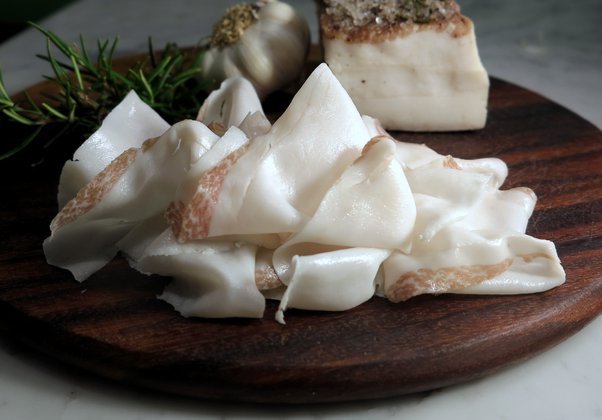
Battuto di lardo (whipped lardo)
There are a handful of different preparation techniques for battuto, but the result is the same. A spread to put on warm bread that can be reasonably described as butter on steroids.
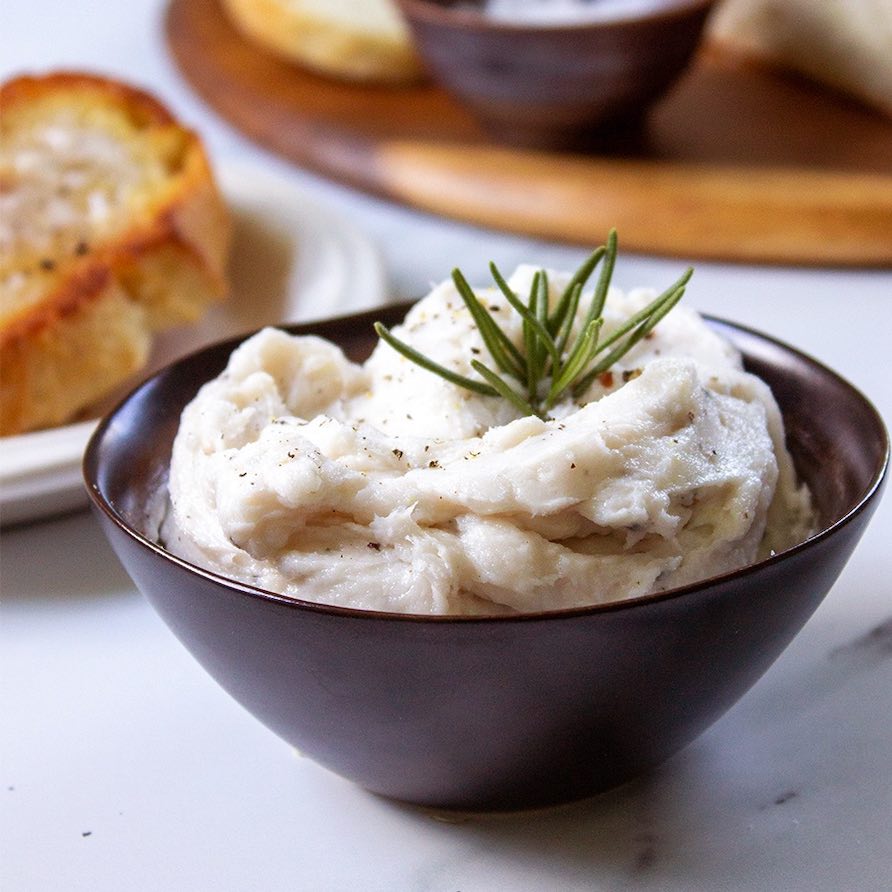
Barding and Larding
Barding is the ancient practice of armoring horses for battle. It’s also the name for covering a roast or large cut of meat with bacon (or, in this case Lardo) before cooking. Larding is a technique wherein the strips of bacon or lardo are woven into the meat, rather than wrapped around it. When the meat cooks, the pork fat melts and absorbs into the roast.
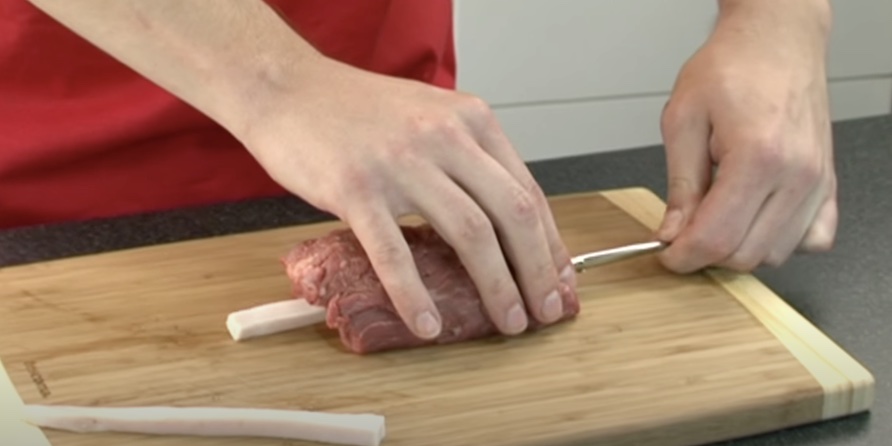
Soups and Sauces
The options here are endless. Need to add some depth to the flavor or texture of a soup or sauce? Is pork flavor appropriate? Then you’ve got yourself a candidate for including lardo. Replace (or augment) the oil used to saute the veggies in the start of a soup. Or cut and fry the lardo into lardons and add to a pasta sauce for a bit of delicious, fatty crunch.
Your imagination is really the limiting factor here. We have a recipe for ziti lardiati if you need an easy introduction to the possibilities.
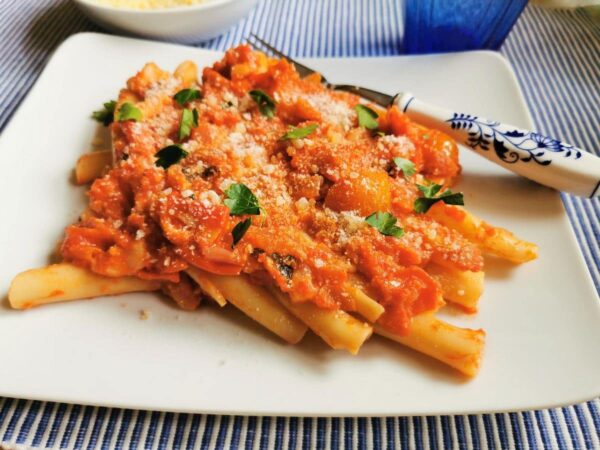
Where to buy Lardo
Italian Deli or Butcher
Unless you live in Italy, it’s likely your local Italian deli does not carry lardo. Recently, I had to go to four different local Italian delis before I found one, and the version they had was produced in the US, not imported. It was delicious, but we were really hoping to find some di Colonnata! Yes, I know, I’m extremely lucky to live in a city with a healthy Little Italy neighborhood.
If your local deli doesn’t carry it, it’s almost certain they can order it for you. You may have to offer to make them some battuto, and you’ll likely have to pay a pretty penny, but it should definitely be possible.
Online
There are lots of places to order Lardo online… if you’re in the EU. For those of us in the US, this side of the pond has very limited options, but I’ve found the following…
One place delivering to Canada…
And some options for our European friends who don’t happen to live in Italy
- Food Explore (di Colonnata)
- Food Explore (d’Arnad)
- The Ham and Cheese Co.
- Volpetti Salumeria
- Italy Food Shop
- Italian Delights
- Fine Food Specialists
How to make homemade lardo
You can certainly cure your own meat at home, that part is easy. The biggest challenge will be to find high-quality fat back. You probably don’t want to buy something from a factory farm – the hormones and antibiotics that are an unfortunate part of our industrial food system tend to accumulate in that in fat. Much better would be to find a local pig farmer that has heritage pigs with a significant thickness of back fat.
Essentially, you give it a dry rub of salt + whatever herbs and seasoning you’d like to infuse the fat with. You could try to mimic the style of Colonnata or Arnad, or create your own. Since you won’t have a marble coffin or a doïl available, you’ll want to use any container that is tall enough for the fat back to sit inside. This could be a stainless steel bowl, a meatloaf pan, a ceramic casserole dish – or any other number of containers you have in your kitchen.
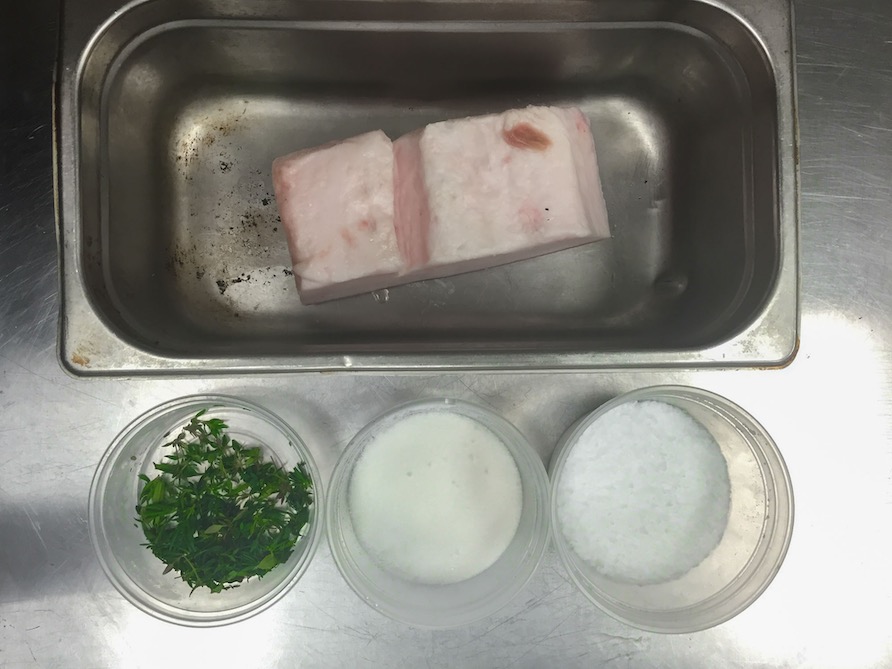
Just make sure the container you choose isn’t something you regularly need. The curing process takes a bare minimum of 2 weeks, but really 6 months is the right amount of time.
Ensure the container is *completely* covered and there is no light making its way inside. The fat needs total darkness to ensure the light doesn’t break down the fat and cause it to go rancid!
I found a great homemade lardo recipe with more information on the process if you’re really interested.
Lardo Recipes
Fat is one of the key, essential ingredients in all forms of cooking. It’s up there with salt. There are a multitude of ways you can cook with it, but here are a few examples to get your mind going…
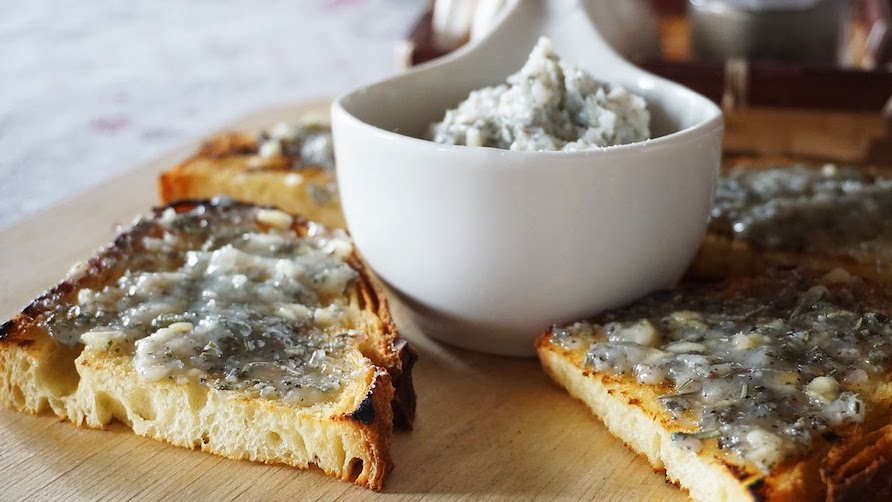
No go track down some lardo and make something beautiful!
